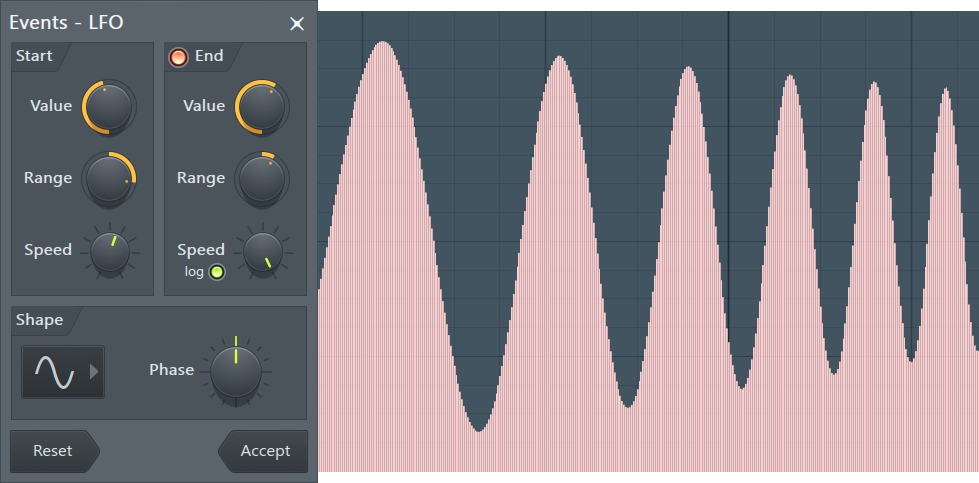
Phase will determine where in the waveform the LFO will start its cycle. Tension controls the shape of the selected waveform. Volume is the amount of LFO you’re adding to the signal. Base controls the starting level of the knob or slider you’re manipulating. By now, you should be familiar with all of the knobs in the LFO section. It’s especially nice to have the ability to randomize any parameter in FL Studio or your plugins.Ī common use for this is to use subtle fine-tune pitch randomization for synths to create a more analog feel to the oscillators. The special thing about Peak Controller is the added wave shapes including saw and random. AMT controls the lowest and highest values of the LFO in terms of depth (volume).Īnother great way to use LFOs in FL Studio is with Fruity Peak Controller.Īfter you add Peak Controller to a mixer insert, you can assign this controller’s LFO to any parameter in FL Studio or any plugin by right-clicking and selecting link to controller and choosing Peak CTRL – LFO from the Internal Control drop-down menu. PW stands for pulse width, which controls how narrow or wide the wave shape is. SKEW will shift the wave shape to the left or the right. TNS controls the tension of the wave shape. The SPEED knob, once again, controls the LFO rate.

By left clicking the automation icon in the top left corner of the clip, you can select channel settings, which has options to use an LFO to draw in your automation for that clip. Once you’ve created the automation clip, it will show up in the playlist. Press ALT+O to access the LFO there.Īnother option you have when you right-click a knob or fader is to create an automation clip. This is also the same LFO window that will pop up in the Event Editor when your right-click any knob or fader in FL Studio and select Edit Events. The phase knob will manipulate where in the LFO waveform to start the LFO signal. You still have the same waveform shapes from the channel LFO (sine, triangle, square). The range will increase or decrease the difference between the highest and lowest values of the LFO. The value knob will control the overall levels of each midi note. Unlike the channel LFO, you can manipulate the beginning in addition to the end of the LFO signal. The piano roll also has its own LFO, which is accessed by pressing ALT+O.
#Xfer lfo tool fl studio mod
Utilizing the LFO to control mod x will help you to achieve the infamous dubstep wobble you hear in a lot of their synths and basses. You can select the filter type from the drop-down menu below. Mod y controls the resonance, which will create a boost or dip at the cutoff point. Mod x is the cutoff knob, which determines at what frequency the sound will be filtered out. These settings apply to the LFOs for each envelope including pan, volume, mod x, mod y and pitch. Without it, the LFO will start over with each new note. Selecting GLOBAL will allow the LFO to continue its cycle as you play new notes. If you select TEMPO, it will match the LFO rates to the project tempo. The SPEED knob controls the rate of the selected waveform in the LFO. The AMT knob controls the range of the LFO.

Increasing the ATT knob will fade in the attack, or start of the LFO. The delay knob will postpone when the LFO becomes active. At the top, you have 3 different LFO shapes including sine, triangle and square from left to right. The blue LFO pictured above controls the volume envelope. There is an LFO automatically assigned to each of the envelope types and filter controls. This is located in the second tab of the sampler channel that is labeled with the automation icon. First, let’s go over the LFO located in the sampler channels. You can also access LFOs in sampler channels, piano roll, playlist and even through FX plugins like Fruity Peak Controller. In FL Studio, many of the stock virtual synths like 3xOsc and Sytrus have LFOs built into them. This is useful for imitating someone turning a knob up and down over and over again at whatever rate you set the LFO to, without physically needing an actual person to do it. If you assign an LFO to either of those parameters, the signal levels will follow the LFO settings in terms of shape, speed, etc. Still, this frequency creates an electrical signal that can be used to modulate parameters of other signals. If you spun it slow enough, you wouldn’t hear any sound at all because the cycle (oscillation) is too slow.

Imagine spinning that same yoyo at a very slow rate (low frequency).


 0 kommentar(er)
0 kommentar(er)
